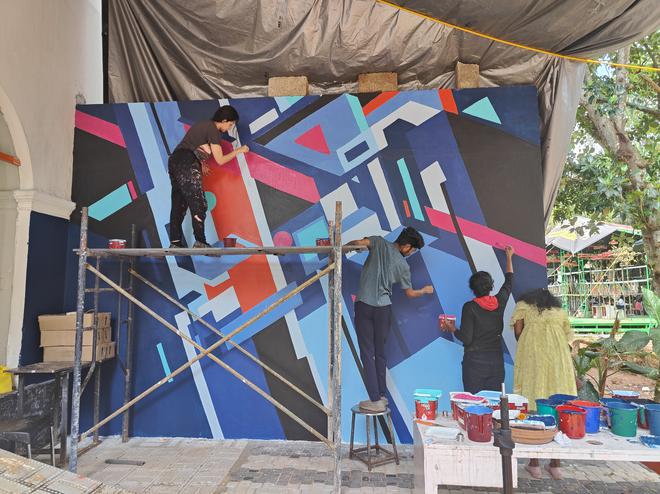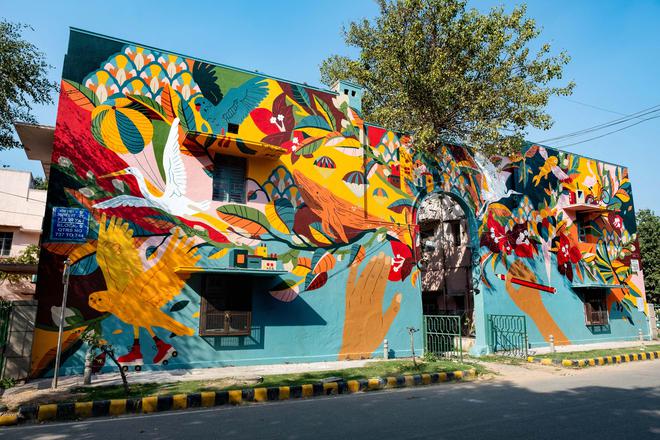Aashti Miller’s hands and clothes are covered with paint — shades of blue and specks of red, yellow and white. Standing next to her wall art on the premises of Vismaya Max, located in the heritage Keston House on Keston Road, she is busy posing for photographs with visitors and some of the artists who assisted her.
Architect-artist Aashti was on her first trip to Thiruvananthapuram to participate in the third edition of the wall festival organised by the Alliance Francaise in association with the French Embassy in India.
Measuring 10 feet by 16 feet, Aashti’s wall art, Vellam (water) is dominated by geometric shapes painted in shades of blue to “signify the relationship of the city and water”. It depicts the city’s urban layout and intricate network of waterways, captured in myriad shades of blue, which connect the city.
She explains that the basic outline is an “abstraction of the city grid and how it is intersected by water”.

“Water is a hot button issue in Kerala. Now, with the State government focussing on reviving historic waterways in the city that have been lost to time, I wanted to draw attention to the aspect of water versus the city.”
She explains that the entire work was completely planned, the paints colour coded and the drawing completely drawn. Taking a plan of the city, she altered it slightly and then a copy was pasted on the wall.
“It is important for me to know how it will look and what will look right on a certain space. I am an architect and not an artist. So everything is planned.”
The venue was chosen by Alliance Francaise de Trivandrum. The wall art was completed in three days with the help of students of Vismaya Max.
Different strokes
Unlike most artists who work in isolation, Aashti painted with the students. She believes that if one paints something simple, other people can also get involved. “So I made it a point to have them all sign because the best way to preserve wall art is to get other people invested in it. I hope that this stays for a few years.”
She points out this is a work the students will see everyday. So, she is particular that her work should neither be too complicated or too realistic. “Everyone should look at it and take something away from it. If it is something simple, others can paint it, like the students here.”
Since the wall art is on the campus of an animation institute, the students are also involved in designing and putting up sets for cinema and theatre. “So, they are prepared. When I needed a ladder, they got one for me. On the second day, it was pouring and the paint from the top of the wall was leaking downwards. I needed a heat gun. The students assured me they would take care of it; they used a heat gun to dry it. They were so resourceful.”
An architect by training, Aashti, a Cornell University graduate, practises in Mumbai. Her illustration and graphic design studio, MillerInk, connects her two worlds, resulting in “drawings that seamlessly merge the digital and analog realms, 2D and 3D. Her work is an exploration of spaces, places, and faces,” states a release from Alliance Francaise de Trivandrum.

She began drawing wall art as an extension of her love for art. Beginning with a painting in Delhi and the Lodhi Art District in March 2022, she moved to Chennai and then to Birmingham in the UK for the 2022 Commonwealth Games. Then she painted in Mumbai and in July, 2023 she was in Germany. She says what began as an expression of her attempt to marry art and architectural practice has now become a passion that has become difficult to stop.
Painting on the walls
“I think architects have a special liking for walls. I know so many artists who have become mural artists. It is in a public space and it is about contributing to what exists around by taking in ideas and aspects from the environment. These are all things you do as an architect. So, again these are all things you can do as an artist. I find wall art very relaxing.”
From Thiruvananthapuram, Aashti moves to Mumbai, Bhopal and Chandigarh. She explains that all three murals have some representation of the natural elements in the city.
Tale of cities
“Each mural is completely different. But I like to tie them all to tell one story, so you can the progression as we move from one city to the next.”
She adds: “Vellam is about water and the city; the one in Mumbai is about earth, land and the city, a hot subject in the city; and in Bhopal, it will be about greenery, nature and the city. All of them graphically are a little similar but the colour palette is completely different and they all have a purple line that goes through them. If someone goes and sees all three of them, you can make the connection that all three are related. All the cities are related and so are all people, in a way.”
In Mumbai, she will paint a wall 90 foot by 17 feet at the iconic Bombay Gymkhana. “They want something that works with the Alliance Francaise and also refers to sports and the history of the club.”
Commenting on the wall art project Arteria that had eminent artists painting certain sections of public buildings in the city, she says, “I saw some the work as we were driving by. I like cities where people are being introduced to art in public spaces. I like the diverse styles that ensure that there is something for everyone.”







